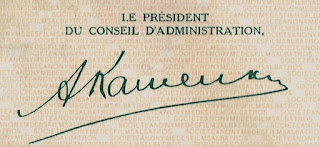I'm sure you recognized the Disney vignette as one of the three visual cues from Puzzle No. 6 . Even with the other vignettes provided, solving the puzzle was not straightforward. Yet I did receive one correct answer.
The three visual cues were clippings from three different stock and bond certificates. The common link between the cues was a particular object.
The correct answer for the puzzle was ... (drumm roll in the background) ... the Liberty Bell.
Shares from the American Union Fire Insurance Company from Philadelphia, PA, show the Liberty Bell in front of the city's Independence Hall. Printed by the Security Bank Note Company, this share certificate was issued in 1910. Things were not going well for the insurance company. It liquidated in 1913.
The Liberty Bell was made in Great Britain by a foundry that became known as Whitechapel Bell Foundry, a producer of many famous bells such as the Big Ben in London.
Pennsylvania commissioned the Liberty Bell in 1751 to celebrate the 50th anniversary of William Penn's Charter of Privileges, Pennsylvania's original constitution. After a rough passage across the Atlantic, the bell cracked when it was first rung.
Two Philadelphia workmen, John Pass and John Stow, recasted the bell. Its large distinctive crack, also visible in the vignette above, originated somewhere in the first part of the 19th century. The bell was placed in the tower of the Pennsylvania State House, aka Independence Hall. This leads us to the first cue.
These bonds, issued by the City of Philadelphia in 1866 (upper right image) and 1861, feature the same vignettes, including the city's Independence Hall that housed the Liberty Bell for about two centuries. It is now located in the Liberty Bell Center. This pair of bonds was sold at Holabird Americana's Dec 2020 auction at $50 without buyer's premium.
The bell became a symbol of freedom. In the 1830s several anti-slavery journals featured the bell in their publications. In 1853 President Franklin Pierce visited Philadelphia. He spoke of the bell as the symbol of the American Revolution and Liberty.
George Lippard writes his "Fourth of July, 1776" in 1847. In that story a young boy instructed an aged bellman to ring the bell on America's Independence Day. But that was not correct. Historians assume that the Liberty Bell rang on July 8th to summon the people to hear the Declaration of Independence read out aloud for the first time. Anyway, Lippard's story was widely reprinted and retold as 'historical fact' for many decades to come.
On the occasion of Philadelphia's 1876 Centennial International Exhibition a replica of the Liberty Bell was cast. It weighed 13,000 pounds (5900 kg), more than six times the weight of the original bell.
The Liberty Bell was not displayed at Philadelphia's Centennial Exhibition. But it made several trips to various other expositions and celebrations in the years thereafter. This brings us to the second cue of puzzle No. 6.
The World's Columbian Exposition, aka Chicago's World Fair, took place in 1893 to mark the 400th anniversary of Christopher Columbus' arrival in the New World in 1492. With 46 countries participating, it attracted over 27 million visitors. This $10 shares certificate from 1893 was printed by the Western Bank Note Company. It sold for $400 excluding buyer's premium in Holabird Americana's 2018 October auction.
In 1893 the Liberty Bell was sent to Chicago's World Columbian Exposition as a highlight of the festivities. It was not the only big bell on display there.
For the World's Columbia exhibition a much larger Columbian Liberty Bell was casted. Two days before the end of the exhibition, Chicago's Mayor Carter Harrison sounded his "new" bell at his final speech on 28 Oct 1893. A few hours later Harrison was assassinated.
The original Liberty Bell returned from Chicago bearing a new crack. Wherever it went, the bell attracted millions of people, more cracking occurred, and souvenir hunters chipped pieces away from it. After 1915 Philadelphia refused any further requests for having the bell featured in events like that.
There was also a third "bell" present at the Chicago event. It was a full-sized model of the Liberty Bell made out of oranges by the State of California. This brings us to our last cue for this puzzle which showed Walt Disney and several Disney figures.
In Holabird Americana's May 2021 auction this Walt Disney stock certificate went $120 excluding buyer's premium. The company displays a full-sized replica of the Liberty Bell in Walt Disney World, Florida.
As part of the US Liberty Bell Savings Bond Drive, the US government ordered 55 full-sized replicas of the Liberty Bell in 1950. These were casted by Fonderie Paccard in France. Shipped as gifts to US states and territories the bells were to be displayed and rung on patriotic occasions.
In 1989 Walt Disney ordered another bell casted by the same foundry from the same mold. It stands now on Liberty Square in the Magic Kingdom, Bay Lake, Florida.
The Liberty Bell sometimes appears on coins, stamps, bonds and stock certificates. I'm interested to see other examples from the latter category. Several American corporations have used the bell's name and image, but none so daringly as the restaurant chain Taco Bell.
On April 1, 1996, Taco Bell launched an ad in the newspapers posting that it had purchased the Liberty Bell and renamed it the "Taco Liberty Bell". Thousands of outraged people had called Taco Bell headquarters and the bell's caretaker, the National Park Service. By noon it was told that the story was a joke. The company's publicity stunt allegedly led to nearly a $1,000,000 rise in sales that week.
I received one joint correct answer on this puzzle from Randy & Scott. Well done! You are now entitled a portion of "eternal fame".
F.L.
Reference links
- worldsfairchicago1893.com, a great resource on Chicago's 1893 World's Fair
- National Park Service
Previous posts
















